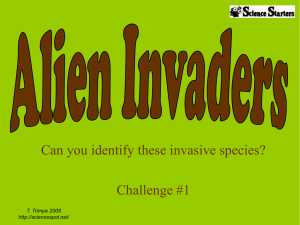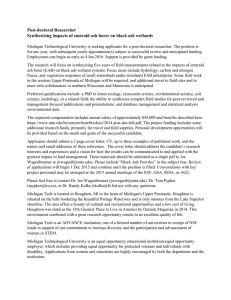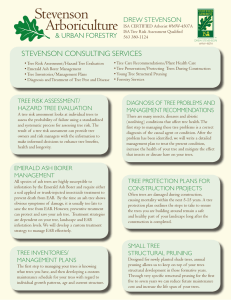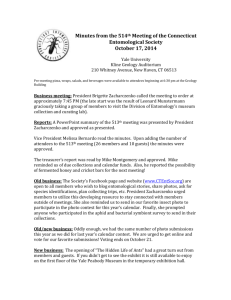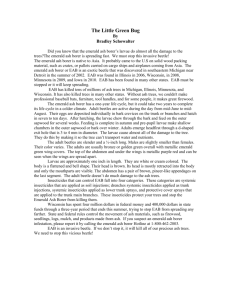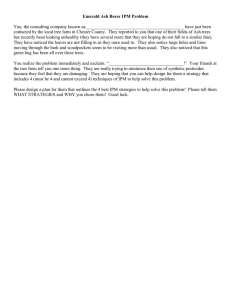Educational information useful to K-12
advertisement
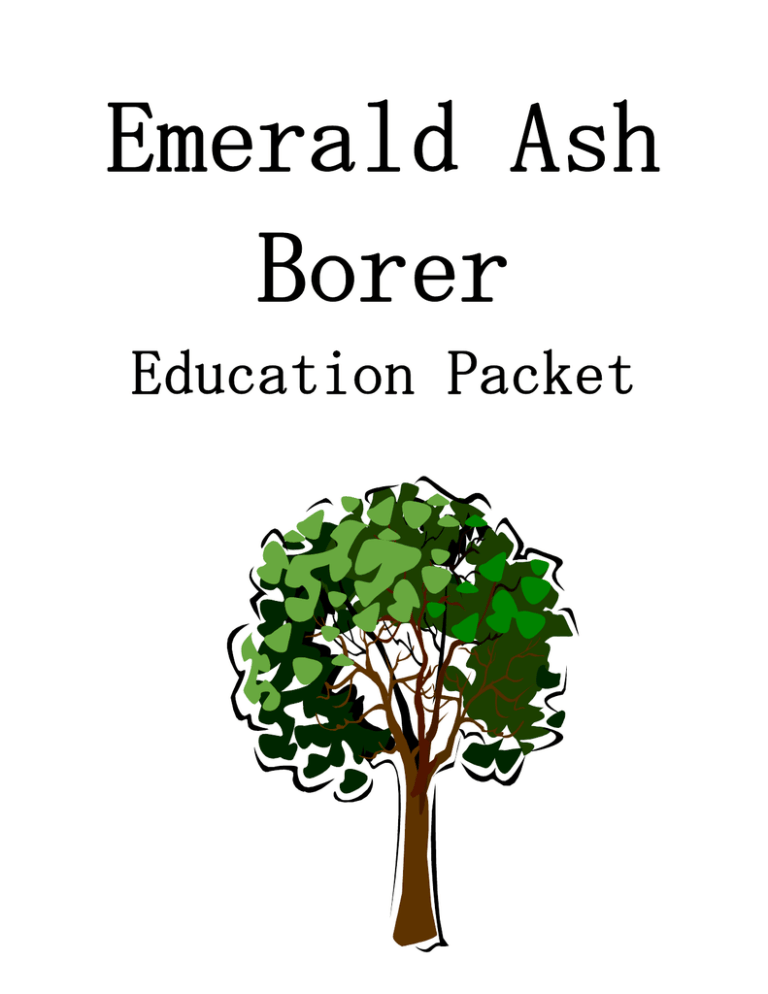
Emerald Ash Borer Education Packet This Booklet was put together with funding from the USDA Forest Service Northeastern Area, State and Private Forestry And input from many sources, including: Michigan Arbor Day Alliance Minnesota Arbor Month MSU Extension Michigan State University SE Michigan Resource Conservation and Development USDA APHIS Conservation Districts Michigan Department of Natural Resources Michigan Department of Agriculture Project Learning Tree Greening of Detroit Several teachers in Ingham county Thank you! For additional copies or more information, please go to www.emeraldashborer.info Table of Contents Emerald Ash Borer Background Information Frequently asked Questions Map It! Locate EAB infestations (SG) EAB Word Search (S) EAB Crossword Puzzle (S) Tree Bingo - Have some fun learning facts about trees (S) EAB Game – Demonstrate the spread of EAB. (SM) Straw Game and Perfect Urban Tree – simulate tree processes (SA) What Can you do? - Ideas for action! (SCE) How to Use an Ash Tree – Discover uses for ash wood (SC) Smart Street vs. Waste Street – (SCE) Native Americans and EAB - Discussion of cultural implications of EAB (SC) Teacher Guide – Invasive Species Activity – Detect relationships in an ecosystem (SC) Non-Native Species Project – Prepare a presentation to share with class (SCE) Resources Emerald ash borer Evaluation Topics S = Science C = Social Studies/cultural A = Art E = English M = Math G = Geography Emerald Ash Borer Emerald ash borer (EAB), Agrilus planipennis Fairmaire, is an exotic beetle that was discovered in southeastern Michigan near Detroit in the summer of 2002. The adult beetles nibble on ash foliage but cause little damage. The larvae (the immature stage) feed on the inner bark of ash trees, disrupting the tree's ability to transport water and nutrients. Emerald ash borer probably arrived in the United States on solid wood packing material carried in cargo ships or airplanes originating in its native Asia. Emerald ash borer is also established in Windsor, Ontario, was found in Ohio in 2003 and northern Indiana in 2004. Since its discovery, EAB has: • Killed at least 15 million ash trees in Michigan, Ohio and Indiana. Most of the devastation is in southeastern Michigan. • Caused regulatory agencies to enforce quarantines ( Ohio, Indiana, Michigan) and fines to prevent potentially infested ash trees, logs or firewood from moving out of areas where EAB occurs. • Cost municipalities, property owners, nursery operators and forest products industries tens of millions of dollars. What's Being Done • A concerted effort to stop EAB has been launched by state and federal officials. • Research is being conducted at universities, as well, to understand the beetle's life cycle and find ways to detect new infestations, control EAB adults and larvae, and contain the infestation. • Eradication efforts by state and federal agencies in Michigan, Ohio, Indiana and Canada are under way to prevent small infestations from growing into large infestations. • Quarantines are in place to prevent infested ash firewood, logs or nursery trees from being transported and starting new infestations. What to know about EAB: • It attacks only ash trees (Fraxinus spp.). • Adult Beetles are metallic green and about ½-inch long. • Adults leave a D-shaped exit hole in the bark when they emerge in spring. • Woodpeckers like EAB larvae; heavy woodpecker damage on ash trees may be a sign of infestation. • Firewood cannot be moved in many areas of Michigan, Ohio and Indiana because of the EAB quarantine ( Ohio, Indiana, Michigan) • It probably came from Asia in wood packing material. If you suspect you may have EAB in your ash trees, call these numbers: Michigan - 1-866-325-0023 Indiana - 1-866-NO-EXOTIC Ohio - 1-888-OHIO-EAB USDA APHIS 1-866-322-4512 Frequently Asked Questions 1. Where did the emerald ash borer come from? The natural range of Agrilus planipennis, or the emerald ash borer, is eastern Russia, northern China, Japan, and Korea. Before June of 2002, it had never been found in North America. 2. How did it get here? We don’t know for sure, but it most likely came in ash wood used for stabilizing cargo in ships or for packing or crating heavy consumer products. 3. What types of trees does the emerald ash borer attack? In North America, it has only been found in ash trees. Trees in woodlots as well as landscaped areas are affected. Larval galleries have been found in trees or branches measuring as little as 1-inch in diameter. All species of North American ash appear to be susceptible. 4. Where has it been found? The “core infestation” was initially designated as 6 counties in southeast Michigan: Livingston, Macomb, Monroe, Oakland, Washtenaw and Wayne. As of December 2004, the quarantined area now contains an additional 15 counties surrounding those just mentioned: Branch, Calhoun, Clinton, Eaton, Genesee, Gratiot, Hillsdale, Ingham, Jackson, Lapeer, Lenawee, Saginaw, Sanilac, Shiawassee, and St. Clair. Emerald ash borer has also been found in a few isolated locations in Michigan’s lower peninsula as well as northeastern Indiana and northwestern Ohio. These outlier infestations are not new (i.e., EAB has not spread this far in the past 2 years). We are simply getting better at finding infestations as survey methods improve. However, it is important to watch for signs and symptoms of EAB in non-quarantine areas where the beetle may have been accidentally transported in ash firewood. 5. What happens to infested ash trees? The canopy of infested trees begins to thin above infested portions of the trunk and major branches because the borer destroys the water and nutrient conducting tissues under the bark. Heavily infested trees exhibit canopy die-back usually starting at the top of the tree. One-third to one-half of the branches may die in one year. Most of the canopy will be dead within 2 years of when symptoms are first observed. Sometimes ash trees push out sprouts from the trunk after the upper portions of the tree dies. Although difficult to see, the adult beetles leave a "D"-shaped exit hole in the bark, roughly 1/8 inch in diameter, when they emerge in June. 6. What do emerald ash borers look like? The adult beetle is dark metallic green in color, 1/2 inch-long and 1/8 inch wide. 7. What is the life cycle of this borer? Recent research shows that the beetle can have a one-, two-, or even three-year life cycle. Adults begin emerging in mid to late May with peak emergence in late June. Females usually begin laying eggs about 2 weeks after emergence. Eggs hatch in 1-2 weeks, and the tiny larvae bore through the bark and into the cambium – the area between the bark and wood where nutrient levels are high. The larvae feed under the bark for several weeks, usually from late July or early August through October. The larvae typically pass through four stages, eventually reaching a size of roughly 1 to 1.25 inches long. Most EAB overwinter in a small chamber in the outer bark or in the outer inch of wood. Pupation occurs in spring and the new generation of adults will emerge in May or early June, to begin the cycle again 8. How is this pest spread? We know EAB adults can fly at least 1/2 mile from the tree where they emerge. Many infestations, however, were started when people moved infested ash nursery trees, logs, or firewood into uninfested areas. Shipments of ash nursery trees and ash logs with bark are now regulated, but transport of infested firewood remains a problem. PLEASE – do not move any ash firewood or logs outside of the quarantined area. 9. How long has the emerald ash borer been in Michigan? No one knows for sure. Experts feel that it may have been in the Detroit area for at least 12 years. The initial infestation probably started from a small number of beetles. Over the next few years, the population began to build and spread. By 2002, many trees in southeastern Michigan were dead or dying. In North America, native ash trees have little or no resistance to EAB and natural enemies have so far had little effect when EAB populations are high. 10. Does it only attack dying or stressed trees? Healthy ash trees are also susceptible, although beetles may prefer to lay eggs or feed on stressed trees. When EAB populations are high, small trees may die within 1-2 years of becoming infested and large trees can be killed in 3-4 years. 11. What is being done on a statewide basis about this new pest? The agencies listed below are working together to educate Michigan citizens about identification of ash trees and EAB, options for protecting valuable shade trees, and locations where dead or dying ash trees can be taken for disposal. State and federal agencies have programs in place to help restore the urban forest in cities that sustained heavy EAB damage. An intensive survey and detection program has been implemented across much of northern Michigan. Several localized “outlier” populations that were found in northern or western lower Michigan have been eradicated. Research is underway to learn more about the biology of EAB, its rate of spread, methods for EAB detection, predators and other natural enemies that may attack EAB, and how insecticides can be used to protect trees in infested areas. 12. Who do I call to get more information on the Emerald Ash Borer or to report an infested tree? Contact your county Michigan State University Extension office, the nearest Michigan Department of Agriculture office, or the Michigan Department of Natural Resources. You may also contact the Emerald Ash Borer Hotline toll-free at 1-866-325-0023. More information is available at the following web sites: www.na.fs.fed.us/spfo/eab/index.html www.emeraldashborer.info www.michigan.gov/eab Michigan State University Michigan Department of Agriculture USDA-Forest Service Michigan Department of Natural Resources U. S. D. A.-USDA Animal and Plant Health Inspection Service APHIS This fact sheet was updated by Dr. David Smitley, Dr. Deborah McCullough, and Dr. Eric Rebek Michigan State University Extension, February 2005. MAP IT! Use these maps to shade in current emerald ash borer infestations Figure 1: Map of Michigan by county Figure 2: Map of the United States EAB Word Search N E E N U J G E S A P B O R A R O B F E E S W D . . . G U O E H H O T N G N T I O E A . . . . I S R L W O L E D E D E T T O K E V R A O S H I . . . . E I E F D M D L F O E A V R A L . . ! Find these words. Then unscramble the remaining letters to figure out the message. EAB Kill Sap Feeding Green Beetle Firewood Leaf Bugs Eggs D Hole June Ash Tree Larvae Shoots Eat EAB Crossword 1 2 2 3 3 4 4 5 5 6 7 6 8 8 9 9 10 Across 1) Food source (hint: genus name) 2) Species name: <genus name> < this answer > 3) Symptom: Adult exit 4) First stage of life cycle 5) Type of insect 6) Life cycle stage that causes the most damage 7) Main source of artificial spread 8) Infestation causes almost certain _______ of ash trees 9) Genus name 10) The _________ larvae kill the trees 1) 2) 3) 4) 5) 6) 7) 8) 9) Down Adults feed on this Bird that eats larvae This bugs distinct color Larvae feed on this part of tree Symptom: Bark _______ Acronym for this bug Subspecies name Symptom: Crown _________ What kind of animal is it? ANSWERS Crossword: F R A X I N U S O P L A N I P 3E N N I S L E I M A 4E G G S G 4P R 5S E T L E H A P L 6L A R V A L 7F I R 6E W O O D I A A E 8T T I B M H S R I 8M O R T A L 9I T Y N A N N R S I R I L U S 10F E E D I N G E C G T 1 W O 3D H O D P 5B E C K E R 2 A G 9 2 Word Search Scramble: Do Not Move Firewood! TREE BINGO Tree Bingo Instructions: Photocopy word squares and bingo grid for each student. Have students cut out word squares and paste them anywhere on the bingo grid. Have students use the remaining blank paper around the word squares to make bingo markers. Read questions. Students say “bingo” when they have covered four words in a row (down, across, or diagonally). Tree Bingo Questions • • • • • • • • • • • • • • • • What month is Arbor Day celebrated in Michigan? April What is Michigan’s state tree? White pine What is the part of the tree that grows deep into the ground? Roots What part of the tree protects it from injury? Bark What parts of the tree are called the crown? Branches and leaves What do you plant to grow a tree? Seed What is a tree called that loses its leaves in the fall? Deciduous What is a tree called that doesn’t lose its leaves (needles) Coniferous Trees take in Carbon Dioxide and put out ______? Oxygen Ash lumber is used to produce railway ties and _____ bats. Baseball Campers can accidently move insect pests by transporting ? Firewood When you plant a variety of trees, you are planting for _______. Diversity An _____ insect is one that comes from another country. Exotic When we turn old paper into new, usable paper it is called _______. Recycling Free Space Free Space TREE BINGO April Oxygen Firewood Free Space Deciduous Branches and leaves Conifer Exotic Free Space Diversity Roots Bark Recycling White pine Seed Baseball Emerald Ash Borer Game Use first page of game for younger students – add firewood variation for older students Materials: Print out several copies of the beetle pages on green paper. Cut out the individual cards and laminate them if possible. Copy more than enough for each student. Tell the students that they will all be ash trees. Their feet are the roots, and can’t move. Their arms are the leaves and they should make a circle over their head. (They have to be somewhat close together for this to work properly). Round 1: Tell them that the emerald ash borer just infested an area. Give one student a beetle card. He/she should hold that card up over his/her head. Tell the class that one beetle will lay lots of eggs. Round 2: Hand the original student a handful of cards and tell him to pass them out to anyone that he can reach. (some students might refuse to take them because they don’t want to get “infested” but they have to if they are within an arm’s reach.) Count the number of “infested trees” Round 3: and onward At this point you should have several students infested. Hand the newly infested trees more beetle cards so that they can pass them out to anyone they can reach.. Record the number of infested. Continue until everyone (or almost everyone) is infested. You can also tell the students that the beetle causes the trees to slowly starve to death. They can act this out! Initial Beetle Round 2 Round 3 # of infested “Trees” Round 1 1 Round 2 Round 3 Round 4 Round 5 Round 6 ***Potential graph activity!! Keep track of how many trees are infested after each round. When you have finished the activity, have your students sit down and chart the # of trees infested (y-axis) vs. the round # (x-axis) *** Eradication/Firewood Variation: Current management for Emerald Ash Borer includes cutting down trees for ½ mile around an infested tree. The class can try the above activity again using the eradication method to try and stop the spread of Emerald Ash Borer. Have everyone stand up again. (at this point students might try and spread out because they catch on that they don’t want to be within arm’s reach.) Remind them that trees can’t move! Hand one card to the first infested tree. Now it’s time to cut some trees. In order to save some of the trees you will need to cut a few down to make a large enough area that the beetle can’t fly across. Go through the center of the students and tap several of them. They have been cut down. Make sure to tap enough that the infested trees will not be able to reach the non-infested ones. (figure 1.) Run through the game and it should work that the infestation doesn’t get past the firebreak. You should have only a portion of the students “infested”. You’ve saved the rest of the ash trees! BUT!!! One of the main challenges faced in eradicating this beetle is artificial movement through nursery stock or firewood. You could have one student represent firewood and move them to the unaffected area and have it start again!! Round 1 Round 2 Round 3 Round 4 Round 5 Round 6 # of infested 1 “Trees” Wrap Up: Discuss with the students other methods to eradicate or control the emerald ash borer, GET CREATIVE! Extensions: Create a poster to let people know what the pest looks like and what it does. • Organize a tree planting (either a large tree or seedlings). Discuss the importance of diversity and planting the right tree in the right place. • Collect newspaper articles about Emerald Ash Borer and share new information! Learn how to ID tree species! There are many books and websites devoted to this. Then take the students outside and inventory the trees at your school, in a local park, or have them inventory their yard. Compare the results with the rest of the class. Are there any species that are more common than others? What would happen if a disease wiped out all the maples? Would the school/park look different? Straw game Procedure: • Issue straws to students and have them breathe through the straw, plugging their noses or trusting them to breath through their mouths. • Now have them bend the straw in several places and see how much harder it is to breath through the straw. • Explain how EAB technically cuts off the circulation of the tree, depriving it of it’s life giving nutrients, similar to how the straw when bent cuts off your supply of oxygen. Ask them what would happen if the tree sustains more damage? • Show wood samples or pictures of galleries and EAB damage. Perfect Urban Trees You’ll need: Drawing materials and paper Let student’s imagination’s soar. Design a perfect urban tree. How would it deal with polluted air…a thick gas mask perhaps? How would it protect itself against climbers? Think about the challenges that affect urban trees, then draw the solutions. Possible challenges: pollution, drought, compaction, lawnmowers, insect damage, disease, swings, driving over roots, power lines, and more! What can you do: You’ve spent some time learning about trees. Now it’s time to get out there and make a difference! Plant a tree in your back yard, at a nearby park, or at your school. You can even plan an Arbor Day celebration! Some ideas: • City of Dewitt – Presentation to 1st-3rd graders on the importance of trees and planted a tree. • Alma - Luce Road School in planted 500 seedlings for Arbor Day 2000 • Milford – Milford’s Central Park had a Landscape Architect peak with elementary school children about the importance of trees • Plymouth – Smith School Planted 2 Callery Pears with Third Grade class for Arbor Day • Rochester Hills – Tree planting with city Mayor and local scout group • Detroit – Denby High School Tree 100 students planted trees along school grounds and Skinner Park • Battle Creek – Leila Arboretum- Tree Planting and remarks, 25 trees planted throughout neighborhood • Other ideas: seedling give-away, MADA poster contest, arbor day proclomation, have your school band play ,learn about the history of Arbor Day, cross-cut saw race, and more! To find out more about how to plan an Arbor Day celebration, contact the Michigan Arbor Day Alliance at miarborday@yahoo.com or visit the website at www.miarbordayalliance.org Emerald Ash Borer Projects! You can help teach other people about EAB and firewood At the Cub Scout Blue and Gold banquet held in Gratiot County in the city of Alma on Feb.15.2005, Patricia Lockwood, EAB-Policy Director, Governors Office, presented to Cub Scout Troop 3610 under the leadership of Pack Leader Steven Zinn, a certificate of achievement signed by Governor Jennifer Granholm and Agriculture Director Dan Wyant honoring the Cub Scouts of Gratiot County (not just troop 3610) for their outreach and educational efforts in regards to Emerald Ash Borer. The Scouts passed out literature and door hangers to residents to help identify the Ash Borer and educate the public on not moving firewood. The scouts were also congratulated on their 75th anniversary. Native Americans and EAB The following is a letter regarding Native American’s relationship with Ash trees. Read the letter and then answer the questions that follow. ASH TREES, INDIGENOUS COMMUNITIES AND THE EMERALD ASH BORER The indigenous peoples of the Great Lakes region (Ho-Chunk, Menominee, Odawa, Ojibwe, Oneida, Potawatomi and others) have long standing relationships with each species of ash tree (Fraxinus sp.) found in the regional flora. These trees have been historically and are currently relied upon for multiple uses, most notably the use of black ash (Fraxinus nigra) wood splints by traditional basket makers. Here I present a general summary to describe the relationships between the indigenous communities and the natural resources of the Great Lakes region. I also suggest the importance of including Tribal and First Nation communities in local and regional Emerald ash borer abatement projects. LAND TENURE TRADITIONS Indigenous people have been ecological stewards of the land and natural resources of the Great Lakes region for thousands of years. Traditions vary, but teachings in most communities suggest that the lands and waters of our respective homelands take care of us and we must, therefore, reciprocally take care of our homelands. We are expected to take good care of our homeplace so that our descendants will have the opportunity to live as we live, dependant upon and connected to a diverse set of ecosystems. This land tenure responsibility has existed for thousands of years and continues to this day. I want to clarify what I mean by dependency. When I say we are dependant upon the ecosystems in our home areas, I mean specifically that many people in Indian communities have physical, financial and spiritual relationships with land and water resources. For example, many of our families eat foods that come from our homelands including fish, deer, moose, wild rice, maple sugar, berries, etc. Many of us also pay our bills from funds that we earn selling arts and crafts, firewood, fish, land leases, and so forth. Finally, many of us rely upon medicinal plants, ceremonial sites, sacred places and teachings that are directly tied to the lands and waters of this region. Within Indian communities, plants and animals are regarded as much more than just physical resources. They are seen as living, spiritual entities. They are members of our community and they are our relatives. ASH PRESERVATION IN INDIAN COUNTRY Within local indigenous communities, the people who carry the most knowledge about black ash are the basket makers. Basket traditions are usually maintained within certain families, and those families often rely on plant materials such as black ash splints, along with their artistic talents, to financially sustain themselves. Members of these families are very knowledgeable about black ash distribution and ecology and many are actively involved in protecting ash from emerald ash borer (EAB). If you are working on a local or regional EAB project, I suggest you connect with traditional basket makers because they hold many generations worth of traditional ecological knowledge that will likely be relevant to your project. Although the most fervent drive to protect black ash resources might be found within basket making families, most members of Native communities in the Great Lakes recognize the critical importance of protecting all ash for future generations. These community members may currently serve or be interested in serving as volunteers in ash protection and EAB abatement projects and could help to bolster your existing core of volunteers. Additionally, many Native communities in the region have natural resource and environmental departments that are actively managing lands and engaging in forest protection. Many of these Tribal/First Nation natural resource and environmental departments (along with cultural and historic preservation departments) are working on EAB projects and should be included in EAB management and problem solving teams. These departments are also your best pathways to the aforementioned basket makers and would-be volunteers. Everyone who is interested in fighting EAB comes to the table with a different set of teachings and a different understanding of what it will take to protect ash into the future. It is critical that Tribes/First Nations, federal, state, nonprofit and private entities all work together to devise management strategies that will diminish this prolific forest pest. Nick Reo (Sault Ste. Marie Chippewa) American Indian Liaison Michigan State University Extension (517) 432-7605 reo@msu.edu Questions • How has tradition framed the way Native americans treat their natural resources? • Do all cultures treat their Natural Resources the same? What are the differences? • If the ash forest resource is severely devastated by the emerald ash borer, how will that affect indigenous communities? • Will all indigenous communities be affected? • What information about black ash might the basketmakers be able to share? ** Optional: Find out where Native American Communities exist in your area. Invasive Species Activity What is an invasive, non-native or non-indigenous species? What is a native or indigenous species? *All animals and plants named in this activity are purely fictional and only intended to serve as an example. The Snozberry is a native tree that many other native plants and animals depend on for food, habitat and shade. Since the introduction of the zork, many a poor snozberry has died due to overfeeding on its roots and leaves. Despite their efforts, experts have been unable to control the spread of the zork and people are demanding that a solution to the problem be found. Read the following descriptions of the species involved. This is the only information on the species available to you. • Snozberry: A native tree that needs sun, water and earth to grow. It grows on dry upland sites. • Boogleberry: A tree introduced to the Great Lakes Region from Kazakhstan for its showy flowers. It is elated to the snozberry. Since its introduction, it has proven difficult to control, especially in drainage ditches and wetlands. However, it also grows on dry soils. In its homeland, it grows only on dry sites because other plants out compete it in wetlands and some animals eat it. • Bork: Native insect that feeds on the fruit of the snozberry. It lays its eggs on the branches of snozberries. • Dork: Native insect that feeds on the leaves of the snozberry during all phases of its lifecycle (from birth until death). It lays eggs on the leaves of the snozberry. • Zork: Insect introduced from Kazakhstan to control the boogleberry. Its larvae feed on the roots of both the boogleberry and the snozberry. In addition, the adults feed on the leaves and fruit of both trees. Female adults descend from the tree canopy to the ground, where they bury their eggs. However, the eggs cannot survive extremely wet soil conditions. Although it still eats the boogleberry, it prefers the new sweet taste of the snozberry. • Muncher: Native bird that eats adult borks, dorks, and zorks. • Cruncher: Native bird that only eats bork and dork larvae. • Willycat: Native cat that eats crunchers and munchers. Although not considered endangered, habitat destruction threatens its survival. 1. Make a diagram that shows how these species interact with each other. Be sure to include keys or any other items necessary to explain your diagram. Use color! Be creative! Remember the ideas and diagrams of food chains, food cycles, and food webs. Your group should agree on a diagram and sketch it on a piece of paper. When finished show it to your teacher for approval. After receiving approval, you will be given a large sheet of paper to make your final copy. Use markers and/or colored pencils to enhance your diagram. Your group will now collaborate to answer the following questions. Support your answers 1. Do you think a known predator of the zork from Kazakhstan should be introduced to control it? 2. How do you think the zork can be controlled? What are some methods that may not have been thought of in the species descriptions? 3. Should another herbivore from Kazakhstan be introduced to control the boogleberry? Support your idea. 4. How do you think the boogleberry can be controlled? 5. What information provided in the descriptions was least useful? Why? 6. Do you think that you need more information to resolve this problem? What information do you think you need? How could you obtain this information? Non-native Species Project You and a partner are in charge of a special investigation report dealing with non-native species. Using PowerPoint, create a factual portrayal of a non-native species that is wreaking havoc on the environment. You will present this information to the class. DUE DATE:____________________ Requirements [8 slide minimum, 10 maximum (More allowed only for Bibliography!)]: Slide #/ Initials 1 Type Information Title Species name (& scientific name), Picture, Names of Group Members 2 Physical Description What does it look like? What kingdom is it in? etc. 3 Behavioral description How does it reproduce? What are some unique behaviors it exhibits? 4 Habitat & Niche Where does it live? What does it do? 5 Environmental Effects How has it affected the environment: negatives and positives (?) 6 History Where did it come from? How did it get here? Where is it currently found? 7 Control measures What are we doing to control it? 8 Resources/ Bibliography – Use APA or Biology/Ecology (see any major journal for format) styles for citations. List websites, periodicals and books. You must site at least one periodical and at least one book. You must cite sources on your slides, including photos, throughout the presentation. Non-native species list (choose one): Zebra mussel Asian longhorned beetle Gypsy moth Sea lamprey Kudzu vine European Rudd Phragmites Carp (in MI) White perch Asiatic clam Buckthorn Garlic mustard Eurasian Ruffle Asian ladybird beetle Tree-of-heaven Spiny water flea Common reed European green crab Autumn-olive Bush/Maack’s honeysuckle Eurasian watermillfois/watermilfoil Purple loosestrife Asian carp Rusty Crayfish Snakehead fish Hydrilla Japanese beetle Round goby Quagga mussel Emerald Ash Borer Find more! Emerald Ash Borer Resources For current EAB information • www.emeraldashborer.info - This Web site is part of a multistate effort in Michigan, Ohio and Indiana to bring you the latest information about emerald ash borer. Find information about the latest research, homeowner options, publications, and more! • Michigan Department of Agriculture 525 W. Allegan St Lansing, MI 48909 www.michigan.gov/eab - Michigan Department of Agriculture site dedicated to emerald ash borer. Great resource for maps and up to date management information • Michigan State University Robin Millsap 312 Agriculture Hall East Lansing, MI 48824 (517) 432-1555 ext 169 • USDA Forest Service www.na.fs.fed.us/spfo/eab/index.html • USDA APHIS Sharon Lucik Brighton, MI • http://semircd.org/ash/index.php - Southeast Michigan Resource Conservation & Development Council - ash tree utilization options Emerald Ash Borer Identification Kits – On display at county MSUE and Conservation District offices in Michigan. Contains EAB adult, larvae, wood samples, and educational brochures. Evaluation Please take a moment to give us some feedback! This is a trial educational packet, we hope to get some feedback, make some revisions, and then print the new and improved version. The most important step in developing educational materials is involving educators in the planning of these materials. Basic Information Name ___________________________________________________________ Address ___________________________________________________________ School ___________________________________________________________ Grade _____________________ Have you used any of the materials in your class? Which ones? Would you recommend these materials to another teacher? Does emerald ash borer information fit in with your curriculum? What did you find most useful in this packet? What could be improved?
